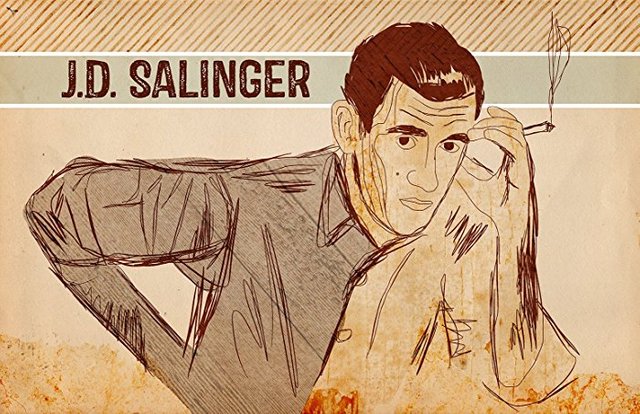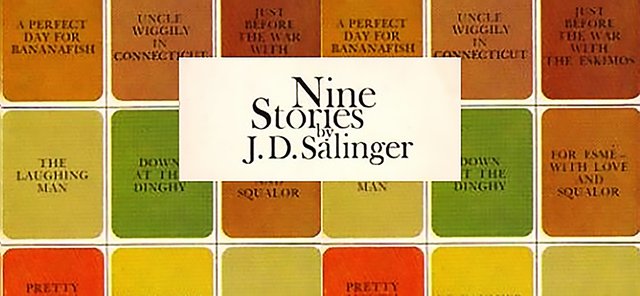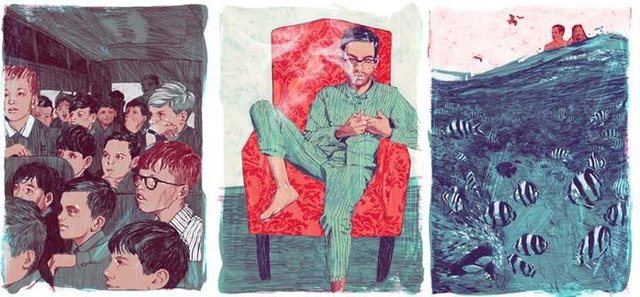Salingerian: The Love of Kids

He never wrote any book for children, yet no writer, in my humble opinion, has ever captured the innocence of a child better than Jerome David Salinger--better known as J.D Salinger.
Catcher in the Rye, Salinger's best known book, tells the story of Holden Caulfield, probably the most beloved disgruntled teenager in all of American fiction history--behind the great Huck Finn, of course! The book has been revered by critics of different generations, not only because of Holden's natural informal prose style filled with slangs and refrains, but mainly because of the genius way in which Salinger captured the seventeen-year-old's psychological struggles, and how various aspects of his life contributes to that struggle.
So that the crowning success of the novel would forever remain the fact that any teenager, even now, more than half a century after the book was published, can absolutely relate to Holden's struggle.
But Salinger's love of kids, and his understanding of them, which, of course, is a product of this love, goes boyond Catcher in the Rye.
In this post I shall be examining this love and understanding, and Salinger's masterful application of it in his short story collection, Nine Stories by J.D Salinger, published in the year 1953, two years after Catcher in the Rye (1951). Although most of the short stories had appeared in The New Yorker or other magazines prior.
Nine Stories by J.D Salinger
All the stories in this collection are masterpieces in their own rights. I kid you not. Like I said, Salinger is the master of capturing childish inoccemce. What is so transcendent about him, though, is that he never did it the cliche way--i.e by highlighting childish naivety or ingenousness or any of those, no--what Salinger did was he showed certain nuances in a child's behaviour. Little details about how a kid walks, talks, scratches hairs; inserts hand in nose, etc.
And it is all this, plus a natural talent for story-telling, that elevates this short story collection to a very high status, securing a place, in my opinion, among the best ever written. And it just so happens that a lot of writers and critics, award winners included, attest to this fact. So please, allow me to take you through the stories one after the other. I promise to try to limit the spoilers as much as I can.
1. A Perfect Day For Bananafish
The first story in the collection brings a character familiar to anyone conversant with J.D Salinger--in the person of Seymour Glass. (Salinger wrote a lot about the Glass family.) But to drive this character; to lend to it that force that made the story resonate, J.D Salinger, of course, employs a child character, by the name of Sybil Carpenter.
This story opens with a lady, bored in her hotel room, who receives a call from her mother who was worried sick about her. Apparently she had traveled with her psychotic husband against their warnings and that of a few doctors. The lady, indifferently, tells her mother not to worry.
The story then switches to the most awesome character in the story--Sybil Carpenter, a young girl who was playing in the hotel beach with her mother.
"See more glass."
The little girl kept telling her mother.
It turned out she was asking for Seymour Glass, who was also at the beach. Sybil, after getting permission from her mother, then rushes all the way to the other side of the beach to meet up with Seymour.
"Are you going in the water, see more glass?" she said.
Here Salinger has endowed Sybil with a vatic capability, the kind children have sometimes without them knowing it, because, even though both of them didn't know it at the time, Seymour was actually going in the water; though a different, more metaphorical kind. Many have wondered why Salinger named the little girl Sybil, and why, of course I think the answer lies here: Sybil, like the legendary Sybil of Cumae, can see the future.
And of course because Salinger is the best at making adorable kids, Sybil can not only predict the future, she is cute as hell. She is smart, she is naive, she believes Seymour's stories about creatures called Bananafishes, and is even jealous of another girl who Seymour Glass let sit on the piano seat with him, going as far as telling Seymour he should have pushed her off.
Well, like I said, it was Sybil Carpenter who acted as a spiritual guide to Seymour, showing him, however indirectly, the path he should take; helping him to finally make his conclusion. And as soon as Seymour returned to the hotel room, back to the lady who had been on the phone earlier, he put his decision into action!

2. Uncle Wiggily in Connecticut
Like I said, all the books in this brilliant collection are masterpieces in their own right; but among the one or two stand-outs among the stand-outs is Uncle Wiggily in Conneticut.
And the best part about Uncle Wiggily, in my opinion, is that it is capable of so many re-reads.
This story opens with Eloise and Mary-Jane, two best friends who had also been college roommates. Mary-Jane has come to visit Eloise, and they both get to talking, while smoking and inebriated.
Ramona! Boy is Ramona awesome! Ramona is, first of all, Eloise's daughter. Ramona has a penchant for a lot of quirky habits. She is marvelously indifferent, she scratches her nose, and most importantly she has a friend, Jimmy Jimmereeno, with whom she made her entrance into the living room. The issue though, see, is that Jimmy Jimmereeno has a slight problem. He isn't real. He's just a make-believe little boy.
It is the entrance, however, of both Ramona and Jimmy, that Salinger uses as a catalyst to spark the main conversation and the crux of the story. Prior to Ramona's entrance the elders had been tergiversating, but now they talk, or Eloise talked, about the love of his life--Walt Glass, from the Glass family--who died in the war.
In the end Ramona comes back and told the adults that Jimmy Jimmereeno has died in an accident. Surprised and amused and confused, the elders sends her to bed, and after Mary Jane leaves, Eloise walks up to Ramona's room, where she finds her sleeping on one side.
"Why are you sleeping way over here?" [Eloise asked Ramona]
"Because," said Ramona.
"Because why? Ramona, I don't feel like- "
"Because I don't want to hurt Mickey."
"Who?"
"Mickey," said Ramona, rubbing her nose. "Mickey Mickeranno."
Classic!
Of course both of them, mother and child, were running after--and away from--ghosts!

3. Just Before the War with the Eskimos
This story is as weird as its title, trust me. In the end you might not exactly get it; honestly, I don't think I did myself. But one thing's for sure, it leaves you feeling disconcerted; a bit sad, even, and with complete loathing for your confusion. I don't think anybody wants to end up feeling that way, which is why, although this has been acclaimed as one of the best story in the collection, it doesn't quite make it to my top 3.
The story opens with two little girls, Ginnie Mannox and Selena Graff, both fifteen years old, who play tennis together every Saturday morning. Apparently Ginnie is mad at Selena because for five straight Saturdays now she has been getting stuck with the cab fare and she wants a refund. Selena, however, doesnt have it, but can get it from her mother, so when the cab dropped them at Selena's house, instead of going on her way, Ginnie follows Selena inside.
Everyone here is little. The main character, however, is Selena's brother, Franklin Graff, whom Ginnie meets while waiting for Selena. Now Selena's brother, Franklin, is not your average kid. He is 24 years old, but shows a lot of childlike--although not childish--tendencies. On entering the living room where Ginnie waited, he had cut his thumb with razor and it was bleeding.
Over the course of their first exchanges, he called Ginnie's elder sister--whom he had a crush on long ago--a snob, but still they both got along, with Ginnie caring for Franklin's hurt thumb by suggesting he put iodine on it, and Franklin caring for Ginnine by asking if she's had lunch yet and would want his sandwich.
Here, then, is where Franklin Graff starts to show some Holden Caulfield-like symptoms; or even worse.
We see the same non-nonchalance, same anger at nothing and everything at the same time (as a means of self-defense, of course). But in Franklin Graff, it is very heightened, and he has no fancy prose style to hide under, because, unlike Holden Caulfield in Catcher in the Rye, this is not Franklin's story to tell.
As we move on we find out something is wrong with Franklin's heart--as we see him rubbing his chest in pain--and that he himself doesn't know what the hell's wrong with it. And when Ginnie advices him to stop smoking, his response was "ah they tellya a lotta stuff." That indifference.
And also it is important to not who they are. And who are they? The adult-world, of course. Of which he now is a part; and which fact, that he is an adult, has caused him so much pain.
It is impossible to read any post war 20th century writer without discerning in the book, a thing or two about either of the Wars. This is one of the few stories, along with For Esme:- With Love and Squalor, teeming with War messages.
Now nt long after he touches his chest in pain, Franklin stands up and walks toward the window.
"Look at'em," he said. "Goddam fools."
"Who?" said Ginnie.
"I don't know. Anybody."
Franklin is obviously one angry, disillusioned boy, just like Holden. Only his pain goes much, much, deeper. And being a genius that he was, Salinger made sure it is a pain he--and we--would never get over, because it is a pain whose exact cause he--and we--would never know.
As the last note on Just Before the War with the Eskimos, I leave you with this dialogue from Franklin and Ginnie:
"We're gonna fight the Eskimos next. Know that?"
"The who?" said Ginnie.
"The Eskimos.... Open your ears, for Chrissake."
"Why the Eskimos?"
"I don't know why. How the hell should I know why....?"